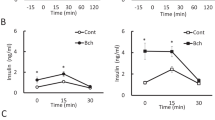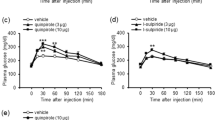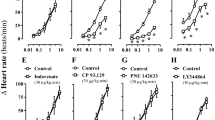Abstract
OBJECTIVES: To further investigate the role, if any, of acetylcholine and the parasympathetic nervous system in modulating β-cell secretion in man.
DESIGN: Oral glucose load (OGTT, 100 g p.o. at 0 min ) alone and preceded by pyridostigmine (PD, 120 mg p.o., 60 min before OGTT), a cholinesterase inhibitor, were administered on two different occasions, in random order, two or three days apart.
SUBJECTS: Ten women with central obesity (OB, body mass index(BMI): 34.3±2.1 kg/m2, waist to hip ratio (WHR): 0.83±0.01, aged 39.0±5.3 y) and six normal women (NS, BMI: 22.7±1.9 kg/m2, WHR: 0.74±0.01, aged 37.1±4.8 y) were studied.
MEASUREMENTS: Serum insulin, plasma glucose and plasma noradrenaline (NA) were measured at −60, −15 and 0 min, and then every 15 min up to +120 min. Insulin concentrations were measured in duplicate by immunoradiometric assay, glucose by glucose oxidase colorimetric method and NA was assayed after extraction with alumina using high performance liquid chromatography with electrochemical detection. Pulse rate (PR), systolic (SBP) and diastolic blood pressure (DBP) were also measured every 15 min during the tests by an automated cuff device.
RESULTS: OGTT raised glucose concentrations in OB and NS (incremental area: 420±44 vs 288±70 mmol/l. 2 h, respectively) without significant differences between groups(F=0.6, P=ns). On the other hand, OB showed an insulin response to OGTT higher than NS (10 120±1074 vs 6692±1962 μU ml−1 2 h, respectively P<0.01). After OGTT alone NA concentrations increased to the same extent in NS (peak vs basal: 1.40±0.16 vs 1.07±0.10 nmol/l, P<0.05) and in OB (peak vs basal: 1.50±0.14 vs 1.04±0.18 nmol/l P<0.05). Both in NS and in OB, PD administration failed to modify basal glucose and insulin (P=ns for both) as well as basal NA concentrations. In NS, the combined administration of PD and OGTT did not modify glucose and insulin responses compared to OGTT alone 335±65.4 mmol/l. 2 h and 6348±1384 μU ml−1 2 h, respectively) while in OB, PD significantly increased the insulin response to OGTT (14640±3030 μU ml−1 2 h, P<0.03), while the glucose response was not significantly different from OGTT alone (478±45 mmol/l. 2 h). PD administration did not modify the NA response to OGTT, in NS or OB (P=ns). In both groups, pyridostigmine administration did not affect systolic or diastolic blood pressures, but decreased pulse rate to the same extent in NS (74±2 vs 66±2 beats/min, P<0.05) and in OB (72±1 vs 67±2 beats/min, P<0.05).
CONCLUSIONS: Our present data indicate that in man, as in animals, acetylcholine has a stimulatory influence on insulin secretion.
This is a preview of subscription content, access via your institution
Access options
Subscribe to this journal
Receive 12 print issues and online access
$259.00 per year
only $21.58 per issue
Buy this article
- Purchase on Springer Link
- Instant access to full article PDF
Prices may be subject to local taxes which are calculated during checkout
Similar content being viewed by others
Author information
Authors and Affiliations
Rights and permissions
About this article
Cite this article
Rio, G., Procopio, M., Bondi, M. et al. Cholinergic enhancement by pyridostigmine increases the insulin response to glucose load in obese patients but not in normal subjects. Int J Obes 21, 1111–1114 (1997). https://doi.org/10.1038/sj.ijo.0800523
Received:
Revised:
Accepted:
Issue Date:
DOI: https://doi.org/10.1038/sj.ijo.0800523



